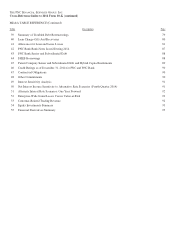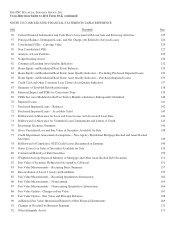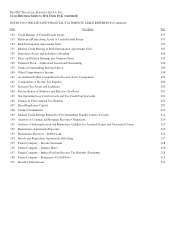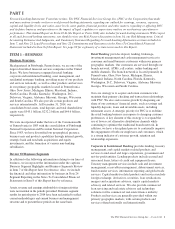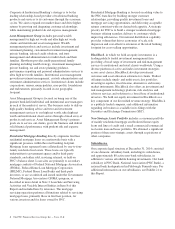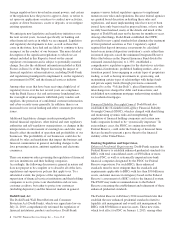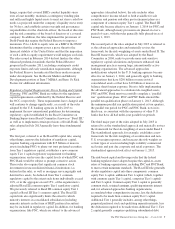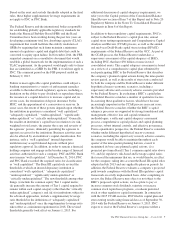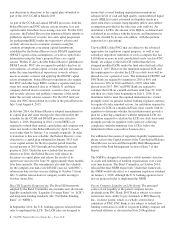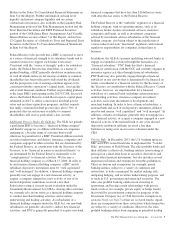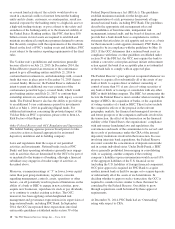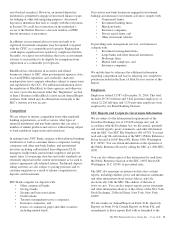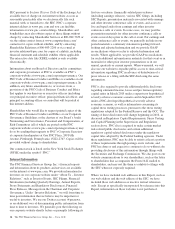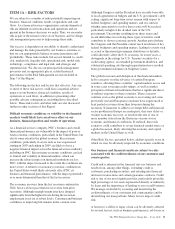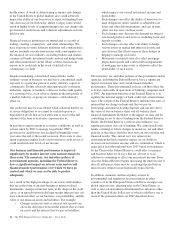PNC Bank 2014 Annual Report Download - page 24
Download and view the complete annual report
Please find page 24 of the 2014 PNC Bank annual report below. You can navigate through the pages in the report by either clicking on the pages listed below, or by using the keyword search tool below to find specific information within the annual report.Total capital is the sum of Tier 1 and Tier 2 capital, less the
deductions required from total capital. For additional
information regarding the differences between Basel III
common equity Tier 1 capital and Basel I Tier 1 common
capital, see the Capital section of the Consolidated Balance
Sheet Review section of Item 7 of this Report.
Under the regulatory capital rules, a banking organization’s
risk-based capital ratios are calculated by allocating assets and
specified off-balance sheet financial instruments into risk-
weighted categories (with higher levels of capital being
required for the categories perceived as representing greater
risk), which are used to determine the amount of a banking
organization’s total risk-weighted assets (RWAs). Under the
standardized approach, the nominal dollar amounts of assets
and credit equivalent amounts of off-balance sheet items are
generally multiplied by one of several risk adjustment
percentages set forth in the rules and that increase as the
perceived credit risk of the relevant asset increases. For
certain types of exposures, such as securitization exposures,
the standardized approach establishes one or more
methodologies that are to be used to calculate the risk-
weighted asset amount for the exposure.
As a result of the staggered effective dates of the final U.S.
capital rules issued in July 2013, as well as the fact that PNC
remains in the parallel run qualification phase for the
advanced approaches, PNC’s regulatory risk-based capital
ratios in 2014 were based on the definitions of, and deductions
from, capital under Basel III (as such definitions and
deductions are phased-in for 2014) and Basel I risk-weighted
assets (but subject to certain adjustments as defined by the
Basel III rules). As of January 1, 2015, and until PNC has
exited parallel run, PNC’s regulatory risk-based Basel III
ratios will be calculated using the standardized approach for
determining risk-weighted assets, and the definitions of, and
deductions from, capital under Basel III (as such definitions
and deductions are phased-in through 2019). Once PNC exits
parallel run, its regulatory risk-based capital ratios will be the
lower of the ratios calculated under the standardized approach
or the advanced approaches. We refer to the capital ratios
calculated using the phased-in Basel III provisions as the
Transitional Basel III ratios. The Transitional Basel III
regulatory capital ratios of PNC and PNC Bank as of
December 31, 2014 exceeded the applicable minimum levels
in effect for 2014. For additional information regarding the
Transitional Basel III capital ratios of PNC and PNC Bank as
of December 31, 2014, as well as the levels necessary to
exceed the regulatory minimums and those needed to be
considered “well capitalized”, see the Capital portion of the
Consolidated Balance Sheet Review section of Item 7 of this
Report.
The Basel III capital rule requires that banking organizations
maintain a minimum common equity Tier 1 ratio of 4.5%, a
Tier 1 capital ratio of 6.0%, and a total capital ratio of 8.0%.
Moreover, when fully phased-in on January 1, 2019, the rule
will require banking organizations to maintain a common
equity Tier 1 capital ratio of at least 7.0%, a Tier 1 capital
ratio of at least 8.5%, and a total capital ratio of at least 10.5%
to avoid limitations on capital distributions (including
common stock dividends and share repurchases) and certain
discretionary incentive compensation payments. For banking
organizations that are subject to the advanced approaches,
these higher capital conservation buffer levels above the
regulatory minimums could be supplemented by a
countercyclical capital buffer of up to an additional 2.5%
during periods of excessive credit growth, although this buffer
is initially set at zero in the United States.
In December 2014, the Federal Reserve requested comment
on proposed rules that would apply an additional risk-based
common equity Tier 1 capital surcharge of between 1.0% and
4.5% (when fully phased-in on January 1, 2019) to firms
identified as globally systemically important banks (GSIBs)
using a scoring methodology that is based on five measures of
global systemic importance (size, interconnectedness,
substitutability, complexity, and cross-jurisdictional activity).
Based on the methodology proposed, PNC would not be
subject to the proposed GSIB surcharge. In its December 2014
release, the Federal Reserve indicated that there is a
significant gap between the systemic scores of the eight U.S.
BHCs that would be subject to the proposed GSIB surcharge
and other BHCs (such as PNC).
The regulatory capital framework adopted by the federal
banking regulators also requires that banking organizations
maintain a minimum amount of Tier 1 capital to average
consolidated assets, referred to as the leverage ratio. Banking
organizations are required to maintain a minimum leverage
ratio of Tier 1 capital to total assets of 4.0%. As of
December 31, 2014, the leverage ratios of PNC and PNC
Bank were above the required minimum level.
Under the Basel III capital rule, banking organizations subject
to the advanced approaches (such as PNC and PNC Bank) also
will be subject to a new minimum 3.0% supplementary
leverage ratio that becomes effective on January 1, 2018, with
public regulatory reporting of the ratio beginning in 2015.
Unlike the existing leverage ratio, the denominator of the
supplementary leverage ratio takes into account certain off-
balance sheet items, including loan commitments and
potential future exposure under derivative contracts.
Consistent with the January 2014 Basel Committee revisions
to the leverage ratio, the U.S. banking agencies in September
2014 adopted final rules that, among other things, revise the
denominator of the supplementary leverage ratio and the
supplementary leverage ratio disclosures that covered banking
organizations are required to make beginning in 2015. In April
2014, the U.S. banking agencies released final rules imposing
a higher supplementary leverage ratio requirement on BHCs
with total consolidated assets of more than $700 billion or
assets under custody of more than $10 trillion, as well as the
insured depository institution subsidiaries of these BHCs.
6The PNC Financial Services Group, Inc. – Form 10-K



